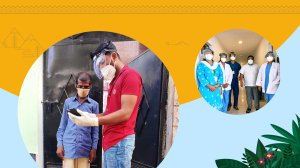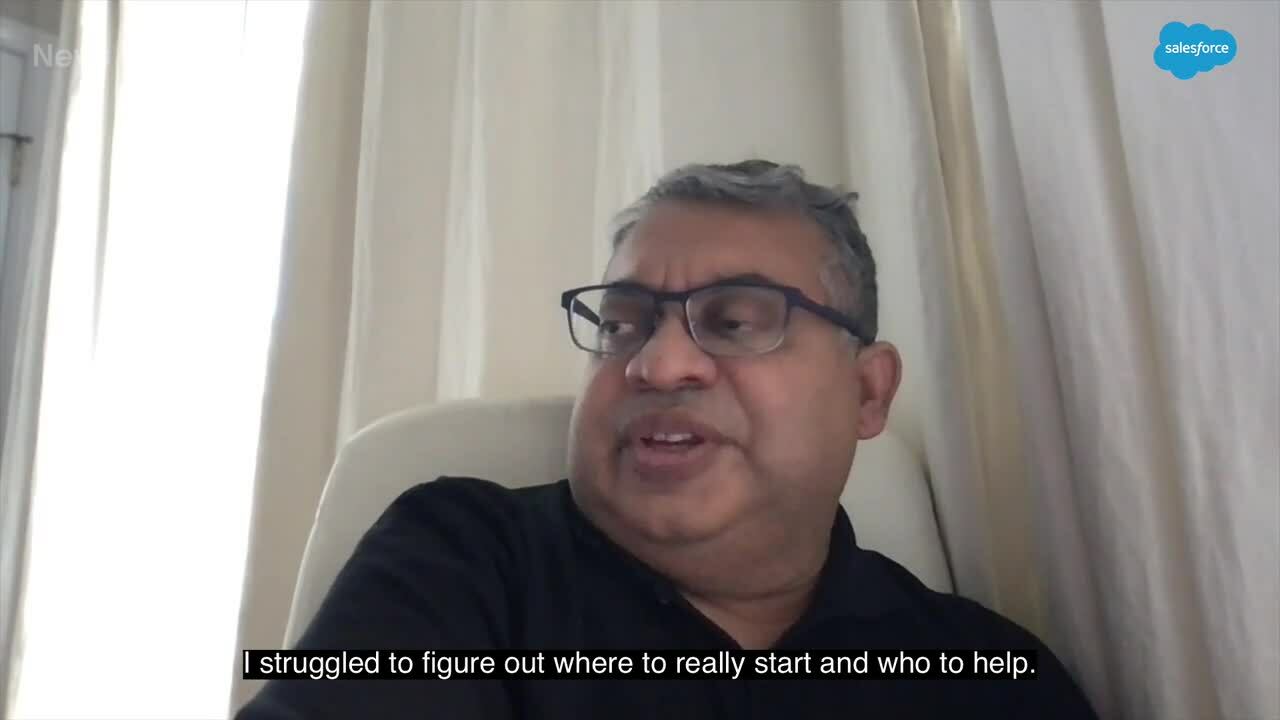How Salesforce Employees Rallied Together to Fight India’s Devastating Second Wave of COVID-19




Sammy Spiegel, Salesforce Newsroom
On April 22, 2021, India hit a devastating world record — the highest single-day tally for new COVID-19 cases since the pandemic began. As India’s health system broke down, hospitals turned away patients, oxygen ran low, and communities suffered.
Immediately, employees on the ground in India and around the world raised their hands to help. Over 2,000 employees came together to stand up an employee hotline, staff volunteer shifts, and even hand-deliver supplies to those in need.
We spoke with some of these volunteers about how they rallied together to help their friends and family and put new Salesforce technology to work in record time.
Divya Ashok watched India’s second wave of the COVID-19 pandemic unfold from her home in San Francisco. As updates flooded her Twitter feed, it was clear that the situation was quickly worsening.
In India, Ashok’s friends and family were struggling to get access to the medical equipment and care they needed as cases and deaths hit record highs.
With over 300,000 deaths and 26 million COVID cases by April, India’s healthcare support call centers couldn’t keep up, and resources rapidly declined.
Ashok was terrified.
“I didn’t know who to reach out to. I was feeling helpless. My family is all out there,” she said.
A COVID-19 helpline becomes a lifeline
Ashok, a VP of Strategy and Innovation at Salesforce, decided to take action, and reached out to a few colleagues who shared a personal connection to India.
“We started by scheduling daily stand-ups to bring about different opinions and learn about what was happening on-the-ground and develop a plan of action — but it became more than that,” Ashok explained. “The daily stand-up calls were an outlet for employees to support each other through the immense stress they all faced.”
Together, they identified the core challenges employees and their families were facing, and what they thought they (and Salesforce) could do to help: create a 24/7 call-in response center to find local medical help, staffed by Salesforce volunteers.
It wasn’t easy, but it was critical.
“The situation on the ground was changing constantly. You would see a tweet from someone who had oxygen, call them five minutes later, and it would be gone,” said Subho Chatterjee, another volunteer.
The Salesforce India COVID Helpline addressed this very real challenge in very real time. Ashok and a few dozen other Salesforce volunteers would personally answer incoming calls, manage real-time data, and track resources across Slack and Quip.
The global team of volunteers would eventually grow to over 1,300. But for the first three weeks, this small group of volunteers managed a growing pipeline of calls, working tirelessly to answer questions and connect people to life-saving resources. This work — physical exhaustion paired with the mental and emotional toll of case management — was difficult to sustain.
“Within a week we went from five calls per day to over 100, working around the clock,” Gagandeep Singh, Senior Manager, Sales at Salesforce’s Gurgaon office, said.
The team entered data by hand, using an assortment of Quip documents and spreadsheets to track resources and the needs of their callers. And while the team fielded hundreds of cases, they struggled to keep up with how fast the situation changed. As word spread and more people reached out, the team needed a way to expand their ability to support the growing volume of calls.
“Time was non-negotiable, we had to move fast. Every minute and every hour counted to make sure that we were providing the right support at the right time. Lives were at stake,” explained Tripti Sheth, Director of Software Engineering.
Ashok decided they needed to bring in reinforcements. So, she sent an email to as many of her colleagues that she could think of who shared a personal connection to India, as well as almost every Executive Leadership Team (ELT) member.
“My hands were shaking — but I knew at most I would get a slap on the wrist. I must’ve emailed 75% of the ELT.”
Within minutes, Ashok received a call from Salesforce’s President and Chief Engineering Officer, Srinivas Tallapragada, who connected Ashok with software engineering SVPs Chatterjee and Ramesh Ragineni. With these connections in place, the small team of volunteers could envision how to scale their impact — a more robust technical solution to manage the overflow.
The technical teams now had an urgent brief to address a budding challenge: If they could scale the help line to intake more calls, manage more cases, and facilitate the inclusion of more volunteers, they could help more people, and potentially save more lives.
The clock was ticking.
Unleashing the power of the cloud to scale a global crisis task force
As the technical team raced the clock, Chatterjee, Sheth and their peers found that helpline volunteers naturally turned to Slack, which allowed for real-time communication. However, other challenges arose. Issues like manual data input, spreadsheet integration, and real-time data updates prevented volunteers from managing the increasing case volume or identifying enough resources with Slack alone.
The team needed a bold way to address them.
“Subho and Ramesh set an audacious target. It was Thursday afternoon, and we wanted a solution by Sunday night,” said Mike Wellner, Director of Technical Program Management.
Sheth set the gears in motion by hosting three scrum calls a day, fielding constant Slack messages and questions, and wrestling with a few stressful questions.
“How were we going to do this? Could we do this?” Sheth asked herself, explaining that this level of cross-team collaboration was unprecedented. As the appointed product manager on the project, Sheth had to focus the team on the goal at hand.
“It came down to purpose. We knew lives were at stake, and the team poured in their hearts and soul to get this done,” Sheth shared.
It came down to purpose. We knew lives were at stake, and the team poured in their hearts and soul to get this done.
Tripti Sheth, Director, Software Engineering, Salesforce
By the end of the weekend, the team briefed, built, tested, and deployed technology that helped the end-to-end process from volunteer management to real-time case management tracking.
Their solution, a custom case management tool built on top of Service and Health Cloud with Einstein AI, Slack, and Heroku apps, enabled the team to intake and manage more requests, onboard more volunteers, and ensure everyone had access to the latest information while maintaining patient confidentiality requirements.
“Slack security review took eight hours, which has never happened before — that has to be a record. Now we know we can move that fast.” Wellner added.
People and technology together deliver global and local impact
Over the course of seven days, the Slack channel helpline swelled to 1,336 members across 48 cities worldwide. These volunteers fielded calls from thousands of people across India, directing them to the resources and help they needed.
But the relief effort didn’t stop there.
Singh, who is based in India, was exhausted and nearing what he hoped would be the end of his 21-hour shift when he received troubling news. One of his co-workers in San Francisco reached out through the Slack channel — his mother, also in India, was sick, alone, and running out of oxygen.
Singh weighed the options. There were no supplies in the immediate area. Her oxygen was low, and checking in to a hospital would likely lead to further complications.
“If someone went to a hospital at the time, based on the statistics, they weren’t leaving that hospital alive. So we had no other options,” Singh said.
If someone went to a hospital at the time, based on the statistics, they weren’t leaving that hospital alive. So we had no other options.
Gagandeep Singh, Senior Manager, Sales, Salesforce
Singh stepped away from his desk where he had been answering hundreds of calls for several days straight, and went outside to find the oxygen himself.
Singh found an oxygen tank in his city, drove it three hours north to his colleague’s mother, and delivered it by hand, saving the woman’s life.
Empathy drives collective action amidst relief effort
With this gesture, Singh, like his fellow volunteers, showed that even with the latest cutting-edge technology at your disposal, the true catalyst to the team’s efforts came down to one simple, shared human value: empathy.
“Everyone from senior leaders to individual specialists and contributors pitched in — roles, titles, none of that mattered. Everyone wore many different hats and came together to make it happen in a matter of a few days,“ Wellner said of the months-long push to provide relief in India.
Chatterjee agrees, and explains that the global effort was a direct example of the values that the company espouses regularly.
“We talk about technology for good all the time, but we witnessed it firsthand, right in front of us.”
We talk about technology for good all the time, but we witnessed it firsthand, right in front of us.
Subho Chatterjee, SVP, Software ENgineering, Salesforce
Learn more about Salesforce’s global response to the COVID-19 crisis in India here.

















